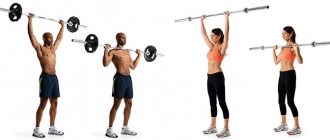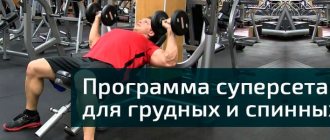Features of training once a week
The most important thing about training once a week is to make sure that you are training a muscle group intensely enough that you can avoid training it for an entire week.
One of the main pitfalls of this type of training is that you do not train it for 7 days. During this time, your body may lose the results you achieved in your last workout.
Think about it. What happens if you stop exercising for a while?
You degrade, the results disappear instantly, and you gradually lose muscle, strength and the success you have achieved.
To a lesser extent, the same thing can ( and often does ) happen when you wait a full week to train a muscle group again.
You can train intensely during a workout, but after a week you may lose your gains and not make any progress.
So, for your once-a-week training to be successful, the volume of training (exercises, repetitions, number of sets) must be intense enough that progress is maintained from workout to workout without exceeding your recovery capacity.
Description of exercises
I offer you a set of exercises for pumping up the recently mentioned muscles: A) muscles of the legs, back and abdomen
Exercise 1 – Roman chair: working – 4 sets, number of repetitions: maximum
Sit on the seat and cross your arms over your chest. Lean back so that your torso is parallel to the floor. Now begin to raise your torso and determine the top point of the amplitude at which the tension in the abdominal muscles disappears. Perform the exercise extremely slowly , moving your torso along an imaginary arc between the starting and ending points of the movement.
Exercise 2 – Squats with a barbell on the shoulders: warm-up – 2 sets of 20 times, working – 3 sets of 10 times
Squats with a barbell on your shoulders are performed with different leg positions , the wider you spread your legs, the greater the load will be, you should NOT spread your legs very wide. When performing this exercise, you should watch your back, keep it straight and do not bend under any circumstances, as this can damage your spine; if your back is not correct, a nerve may be pinched, which can lead you to the operating table. Before you start squats with a barbell on your shoulders, practice the squatting technique itself, initially squat without a barbell, then switch to squats with a bar, and only after you have perfected the squatting technique, switch to a barbell with weights.
Exercise 3 – Lying leg curls: warm-up – 20 times, working – 3 sets of 10 times
Sit on the seat and cross your arms over your chest. Lean back so that your torso is parallel to the floor. Now begin to raise your torso and determine the top point of the amplitude at which the tension in the abdominal muscles disappears. Perform the exercise extremely slowly, moving your torso along an imaginary arc between the starting and ending points of the movement.
Exercise 4 – Pull-ups or rows of a vertical block to the chest: workers – 4 sets of 10 times
Ordinary handles that are attached to the pulley cable are not suitable for performing this exercise. It is better to disconnect them and throw a piece of thick rope over the cable hook. This “improvement” will allow you to pull the block with the most comfortable grip, when your clenched hands are parallel to each other. Without changing the position of your arms relative to your body, begin to lean forward until your forehead touches the floor. You will feel a strong tension in all the muscles in the waist area. Stay at the end point of the amplitude for a couple of seconds and return to the starting position. Repeat the exercise until you completely fail.
B) pectoral and shoulder muscles, arm muscles
Exercise 5 – Incline bench press: warm-up – 2 sets of 15 times, working – 3 sets of 7 times
Raise the back of the bench 35-40 degrees relative to the horizontal. Lie down on a bench, place your feet wider than your shoulders and place them on the floor. Hips, shoulders and head are pressed against the bench. Grasp the barbell with an overhand grip. The distance between the palms is slightly more than shoulder width. Remove the barbell from the supports and smoothly lower it to your upper chest. Inhale and, holding your breath, press the barbell up. Elbows always point to the sides. Exhale only when you have overcome the most difficult part of the climb or when you reach the top point (arms are fully straightened, but not locked at the elbows). At the top point, pause and, with additional effort, tighten your chest muscles even more. Inhale and, holding your breath, smoothly lower the bar to your upper chest, and as soon as you touch it with the bar, immediately change the direction of movement and press the bar up. At the lowest point you can pause. In this case, as soon as the barbell touches your chest, exhale, then inhale deeply and, holding your breath, press the barbell up. All phases of the exercise (lowering and pressing) are performed at a smooth, moderate pace.
Exercise 6 – Dumbbell press on a straight bench: workers – 4 sets of 7 times
Starting position – sitting on a bench, back straight, feet on the floor. Raise the dumbbells up above your head, keeping your arms straight, stop for two seconds at the top, and slowly lower the dumbbells.
Exercise 7 – Standing barbell press: warm-up – 10 times, working – 3 sets of 9 times
Grasp the barbell with an overhand grip slightly wider than shoulder-width apart and stand completely straight. The bar of the bar touches your hips. Place your feet parallel, shoulder-width apart, and bend your knees slightly. You can move one leg slightly forward - this will increase stability. Raise the barbell to your chest.
- The bar touches the upper chest, palms look at the ceiling, the back is slightly arched in the lower back, the shoulders are straightened, the chest is in a “wheel”.
This is the starting position. Inhale and, holding your breath, press the barbell up. After overcoming the most difficult part of the movement, exhale. At the top point, the arms are fully straightened and the shoulders are raised as much as possible. Having reached the top point, stop for a moment and strain your deltoids with all your might. Inhale and hold your breath as you lower the barbell to your chest and then begin the next rep. Press and lower the barbell at a moderate pace, with complete control over its movement. Don't push the barbell out or let it fly on its own.
Exercise 8 - Biceps curls: warm-up - 15 times, working - 4 sets of 8 times
Standing, feet shoulder-width apart. Knees slightly bent, back straight. The arms with the barbell are straightened down. The grip is average, i.e. approximately shoulder width apart. As you exhale: Smoothly bend your elbows and lift the barbell to your chest. Attention! The elbows remain motionless at waist level.
Exercise 9 – French bench press: working – 4 sets of 8 times
The French bench press can be considered a basic exercise for the triceps. This exercise is usually performed with a W-shaped bar on a horizontal bench. When performing lying down, the elbows are almost vertical, with a slight tilt towards the head. The grip is narrow, the barbell is lowered behind the head, the elbows are motionless during the movement. At the bottom point, the arms almost touch the head, at the top point they are completely straightened. The elbows should be fairly close to each other and should not be spread apart. When moving down, inhale; when moving up, exhale.
Earlier articles covered exercises:
- How to pump up your lower abs
- How to pump up your pectoral muscles
- How to pump up your legs
Video
A selection of video exercises for beginners
roman chair
Incline Barbell Press
French bench press
Another problem with such training
The other big problem with training once a week is that you lose an entire week. Even despite a fairly heavy load and maintaining training progress.
Think about it. By training a muscle group once a week, you get 52 workouts per year per muscle group.
If you trained twice a week, you would get 104 training sessions per year.
What do you think will give you the best results in the same amount of time?
Obvious, isn't it?
What I'm getting at is...even if you do everything right by training each muscle group once a week, you're still wasting a lot of time .
You could hit the gym again and increase your progress instead of sitting out for a week.
And it doesn’t even make sense to say that there is nothing special or magical about training once every 7 days.
This is just a random period of time that is not based on anything. There are no advantages here.
It’s just that there are 7 days in a week, so it’s quite convenient to plan workouts once a week.
General rules for creating a program
Regardless of gender, your first workouts in the gym should be treated very responsibly.
Since people who dream of getting rid of fat deposits most often do not engage in sports, their body is not prepared for serious stress. To lose excess weight, beginners must first normalize their cardiovascular system, because if a person spends half an hour in a full workout in the first lesson, this can lead to problems with the joints and heart. It is necessary to take into account the rule of gradual introduction to sports mode. A three-time training plan should start with light exercises, slowly increasing the load. During training, be sure to carefully monitor your heart rate, blood pressure, and breathing rate.
So, is a once-a-week workout routine the best?
I think you already know the answer. In any case, I will say it...
Training once a week is the least effective .
And this is not just my opinion. Any qualified trainer, expert, even not the most educated one, will tell you the same thing.
And guess what else? This is not just an opinion... it is a fact, scientifically proven and confirmed by global indicators.
All scientific research shows that training each muscle group once a week is the least effective way to train, regardless of your goals or fitness level.
Can this work? Certainly. It works? Yes.
Honestly, if you do it right, ANY workout can produce positive results, even this one.
However, the question is not whether it works or not. The question is which works better or worse .
And all the research, all the expert opinions and my personal experience show that regular training once a week is not the best option for most people.
Who might benefit from training once a week?
Training each muscle group once a week is suitable for the following group of people:
- People who use steroids
- People with good genetics
- People whose goal is to maintain muscle mass rather than gain it. In this case, training once a week is the best option.
- Advanced athletes who specialize in specific body parts or muscle groups. They intensively train a specific muscle group, and work the rest of the muscles once a week.
Personally, I would recommend this frequency of exercise only for the last two groups of people. For the first two, regular classes are more suitable.
Full body and running
It would be a good idea to complement your Full body with a toning workout in the form of running. Running will not only help increase the activation of all body systems and improve muscle tone. But running can also contribute to the accumulation of muscle mass.
Interval running for both muscle mass and weight loss
The effectiveness of the process of gaining muscle mass is much higher if you use interval running.
Who is not suitable for training once a week?
As I said earlier, working out once a week is not the best solution for most people .
Perhaps for you too.
For beginner athletes and those whose initial goal is to increase strength and develop muscle shape, it is better to avoid such regularity of training.
Of course, such training will also lead to certain results (given that you do everything correctly). This applies to those who are trying to increase muscle mass, get lean and look better. However, these are NOT the best results you can achieve.
I don't recommend this option to you.
Principles for developing an initial weight loss program
Strength exercises are a determining factor for losing weight, but you shouldn’t take on heavy weights right away.
By adding weight, a beginning athlete will waste energy without completing the entire program. It is better to add several approaches or increase the volume of exercises. When performing any strength exercise, you should carefully monitor your technique. It is advisable to observe yourself in the mirror, tracking the position of your arms, legs and body in space. Correct technique is the key to effective training.
You should not rush, because if a beginner has never played sports in his life, then perhaps even the easiest program will be difficult for him in the first days. In this case, it is better to perform part of the exercises efficiently and correctly than to do the entire program through force and coercion.










